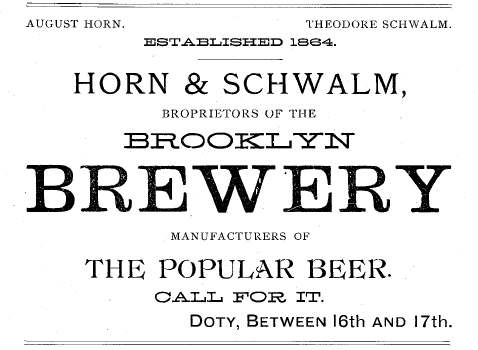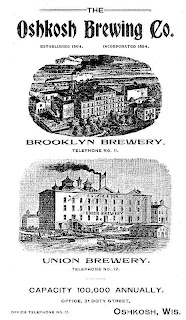On March 28, 1894 – 116 years ago yesterday – the Oshkosh Times ran a story announcing that there was a new business in town calling itself the Oshkosh Brewing Company. Actually, there wasn’t much “new” about the new company. The Oshkosh Brewing Company resulted from the consolidation of Oshkosh’s three largest breweries, The Horn & Schwalm Brewery (aka the Brooklyn Brewery) at the 1600 block of Doty St.; the Union Brewery (aka the Glatz Brewery) also on Doty; and the Kuenzl Brewery (aka the Gambrinus Brewing Co.), located on the East Side of town near the intersection of Harney and Evaline.
 You’d think this would have been big news. After all, here were three of the city's most prominent and visible manufacturing concerns joining forces to create an organization that would surely dominate the brewing and sale of beer in a city that already had a reputation for loving its brew. But there wasn’t much public celebration over the formation of a company that the Times claimed would “undoubtedly attract considerable attention throughout the state and country.” In fact the mood of the merger was downright sullen.
You’d think this would have been big news. After all, here were three of the city's most prominent and visible manufacturing concerns joining forces to create an organization that would surely dominate the brewing and sale of beer in a city that already had a reputation for loving its brew. But there wasn’t much public celebration over the formation of a company that the Times claimed would “undoubtedly attract considerable attention throughout the state and country.” In fact the mood of the merger was downright sullen. The Times article points out that the “interested parties are very reticent about the matter and for some reason have attempted to keep it out of the papers.” After being outed by the Times, the new company released its own glum account of the merger stating that, ”Through the influx of foreign beer, competition has become so strong that in order to cope with it, these companies have been compelled to combine their interests.” Not exactly a happy sounding start to a new business. And if you swap the word Milwaukee for foreign, you’ll know who was causing their worry. Schlitz was already well established here and when Pabst moved its Fond du Lac branch to Oshkosh in 1890 it was obvious to the locals that they’d need to bulk-up to hold their own.
The Times article points out that the “interested parties are very reticent about the matter and for some reason have attempted to keep it out of the papers.” After being outed by the Times, the new company released its own glum account of the merger stating that, ”Through the influx of foreign beer, competition has become so strong that in order to cope with it, these companies have been compelled to combine their interests.” Not exactly a happy sounding start to a new business. And if you swap the word Milwaukee for foreign, you’ll know who was causing their worry. Schlitz was already well established here and when Pabst moved its Fond du Lac branch to Oshkosh in 1890 it was obvious to the locals that they’d need to bulk-up to hold their own.It took a while for the three breweries to adjust to their new allegiance. Two years after the merger, the Brooklyn Brewery contingent was still running ads that made no mention of their stake in the new company. That would gradually change and by 1900 you begin to see ads that no longer make a point of identifying the distinct entities within the Oshkosh Brewing Company. This is also when the image of Chief Oshkosh starts coming to the fore as the company finally coalesced into one big, beer-soaked family.
No comments:
Post a Comment